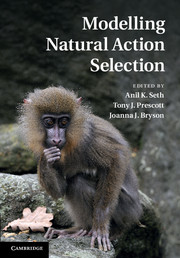Book contents
- Frontmatter
- Contents
- Foreword
- Preface
- Contributors
- 1 General introduction
- Part I Rational and optimal decision making
- 2 Introduction to Part I: rational and optimal decision making
- 3 Do we expect natural selection to produce rational behaviour?
- 4 Optimised agent-based modelling of action selection
- 5 Compromise strategies for action selection
- 6 Extending a biologically inspired model of choice: multi-alternatives, nonlinearity, and value-based multidimensional choice
- 7 Bayesian approaches to modelling action selection
- 8 Post-retrieval inhibition in sequential memory search1
- Part II Computational neuroscience models
- Part III Action selection in social contexts
- Index
- Plate section
- References
4 - Optimised agent-based modelling of action selection
from Part I - Rational and optimal decision making
Published online by Cambridge University Press: 05 November 2011
- Frontmatter
- Contents
- Foreword
- Preface
- Contributors
- 1 General introduction
- Part I Rational and optimal decision making
- 2 Introduction to Part I: rational and optimal decision making
- 3 Do we expect natural selection to produce rational behaviour?
- 4 Optimised agent-based modelling of action selection
- 5 Compromise strategies for action selection
- 6 Extending a biologically inspired model of choice: multi-alternatives, nonlinearity, and value-based multidimensional choice
- 7 Bayesian approaches to modelling action selection
- 8 Post-retrieval inhibition in sequential memory search1
- Part II Computational neuroscience models
- Part III Action selection in social contexts
- Index
- Plate section
- References
Summary
Summary
The problem of action selection has two components: what is selected? How is it selected? To understand what is selected, it is necessary to recognise that animals do not choose among behaviours per se; rather, behaviour reflects observed interactions among brains, bodies, and environments (embeddedness). To understand what guides selection, it is useful to take a normative, functional perspective that evaluates behaviour in terms of a fitness metric. This perspective can be especially useful for understanding apparently irrational action selection. Bringing together these issues therefore requires integrating function and mechanism in models of action selection. This chapter describes ‘optimised agent-based modelling’, a methodology that integrates functional and mechanistic perspectives in the context of embedded agent–environment interactions. Using this methodology, I demonstrate that successful action selection can arise from the joint activity of parallel, loosely coupled sensorimotor processes, and I show how an instance of apparently suboptimal decision making (the matching law) can be accounted for by adaptation to competitive foraging environments.
Introduction
Life is all about action. Bodies and brains have been shaped by natural selection above all for the ability to produce the right action at the right time. This basic fact leads to two observations. First, the neural substrates underpinning action selection must encapsulate mechanisms for perception as well as those supporting motor movements (Friston, 2009), and their operations must be understood in terms of interactions among brains, bodies, and environments. In other words, action selection mechanisms are embodied and embedded. Second, despite the generality of action selection mechanisms, it is unlikely that they can deliver optimal behaviour in all possible situations. Action selection models therefore need to integrate functional and mechanistic perspectives (McNamara and Houston, 2009), especially when observed behaviour departs from what appears to be optimal or ‘rational’ (Houston et al., this volume). The goal of this chapter is to describe and illustrate a methodology – optimised agent-based modelling (oABM; Seth, 2007) – that accommodates both of these observations, and to contrast this methodology with standard techniques in ‘optimal foraging theory’ (OFT; Stephens and Krebs, 1986). The central idea is that the oABM approach provides a unified framework for modelling natural action selection, ‘rational’ and otherwise.
Information
- Type
- Chapter
- Information
- Modelling Natural Action Selection , pp. 37 - 60Publisher: Cambridge University PressPrint publication year: 2011
References
Accessibility standard: Unknown
Why this information is here
This section outlines the accessibility features of this content - including support for screen readers, full keyboard navigation and high-contrast display options. This may not be relevant for you.Accessibility Information
- 1
- Cited by
